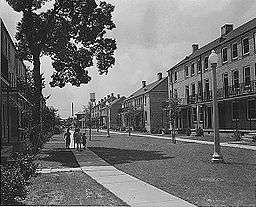St. Thomas Development
| St. Thomas Development | |
| River Garden | |
| New Orleans Neighborhood | |
 St. Thomas Projects, early 1940s | |
| Country | United States |
|---|---|
| State | Louisiana |
| City | New Orleans |
| Planning District | District 2, Central City/Garden District |
| Elevation | 7 ft (2.1 m) |
| Coordinates | 29°55′34″N 90°04′21″W / 29.92611°N 90.07250°WCoordinates: 29°55′34″N 90°04′21″W / 29.92611°N 90.07250°W |
| Area | 0.27 sq mi (0.7 km2) |
| - land | 0.23 sq mi (1 km2) |
| - water | 0.04 sq mi (0 km2), 14.81% |
| Population | 1,091 (2010) |
| Density | 4,041/sq mi (1,560/km2) |
| Timezone | CST (UTC-6) |
| - summer (DST) | CDT (UTC-5) |
| Area code | 504 |
St. Thomas Development is a neighborhood of the city of New Orleans and a former Housing Projects of New Orleans. A sub-district of the Central City/Garden District area, its boundaries as defined by the City Planning Commission are: Constance, St. Mary, Magazine and Felicity Streets to the north; the Mississippi River to the south; and 1st, St. Thomas, and Chippewa Streets, plus Jackson Avenue to the west.
Geography
St. Thomas Development is located at 29°55′34″N 90°04′21″W / 29.92611°N 90.07250°W [1] and has an elevation of 7 feet (2.1 m).[2] According to the United States Census Bureau, the district has a total area of 0.27 square miles (0.7 km2). 0.23 square miles (0.6 km2) of which is land and 0.04 square miles (0.1 km2) (14.81%) of which is water.
Adjacent Neighborhoods
- Lower Garden District (north)
- Irish Channel (west)
Boundaries
The City Planning Commission defines the boundaries of St. Thomas Development as these streets: Constance Street, St. Mary Street, Magazine Street, Felicity Street, the Mississippi River, 1st Street, St. Thomas Street, Chippewa Street and Jackson Avenue.[3]
Demographics
As of the census of 2000, there were 2,957 people, 834 households, and 608 families residing in the neighborhood.[4] The population density was 12,857 /mi² (4,928 /km²).
As of the census of 2010, there were 2,161 people, 1,001 households, and 471 families residing in the neighborhood.[4]
History
The St. Thomas Housing Project was one of the housing projects of New Orleans. It was bordered by St. Thomas Street to the south, a service alley between Constance and Laurel Streets to the north, Felicity Street to the east, and Josephine Street to the west. It was completed in 1941 and originally consisted of 120 buildings covering almost ten full city blocks. Under the segregated housing laws in place until the 1960s, it was occupied by white tenants.
St. Thomas became one of the country's most dangerous housing developments by the late 1980s. In 1991 St. Thomas led all of housing projects in violent crime, according to HANO. from 1987 and 1991 NOPD reported 48 murders, 27 rapes, 370 robberies, and 683 assaults.[5] In 1996, the Housing Authority of New Orleans received a H.U.D. Hope VI grant to demolish and rebuild the area. The grant included the costs of relocating the nearly 3,000 then-residents to other properties.
By the end of 2001, all of the buildings except a few had been demolished to create a mixed-income neighborhood named "River Garden." A section of Chippewa Street was re-aligned in the process. Also, a new Wal-Mart superstore was constructed on long-vacant property one block south of the former project site.
Construction of the rental property was completed in early 2009, with a final phase of construction focusing on condominiums and ground floor retail space. The plans for condominiums did not materialize and were substituted with additional subsidized rental property. Single-family housing was built near the center of the development. HRI, the developer, built approximately one-third of the planned number of single-family homes. At the time of the writing, there were no plans to finish this aspect of the River Garden neighborhood.
Sister Helen Prejean, a Roman Catholic nun, lived in St. Thomas Housing Project in the 1980s. While living there, she became pen pals with convicted killer Patrick Sonnier. Her experiences with Sonnier and other inmates on death row, recorded in her book Dead Man Walking, served as the basis for the feature film and opera. Scenes in the movie version were filmed on location at St. Thomas; Prejean was portrayed by Susan Sarandon.
See also
References
- ↑ "US Gazetteer files: 2010, 2000, and 1990". United States Census Bureau. 2011-02-12. Retrieved 2011-04-23.
- ↑ "US Board on Geographic Names". United States Geological Survey. 2007-10-25. Retrieved 2008-01-31.
- ↑ Greater New Orleans Community Data Center. "St. Thomas Development Neighborhood". Retrieved 2008-06-21.
- 1 2 "St. Thomas Development Neighborhood". Greater New Orleans Community Data Center. Retrieved 6 January 2012.
- ↑ https://news.google.com/newspapers?nid=2209&dat=19921029&id=TolKAAAAIBAJ&sjid=85MMAAAAIBAJ&pg=6932,7074505&hl=en